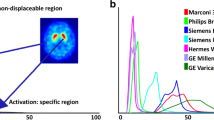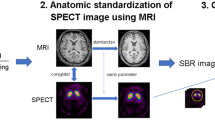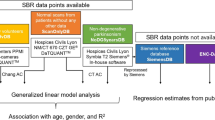Abstract
This paper describes the application of a multivariate statistical technique to investigate striatal dopamine D2 receptor concentrations measured by iodine-123 iodobenzamide (123I-IBZM) single-photon emission tomography (SPET). This technique enables the automatic segmentation of dynamic nuclear medicine images based on the underlying time-activity curves present in the data. Once the time-activity curves have been extracted, each pixel can be mapped back on to the underlying distribution, considerably reducing image noise. Cluster analysis has been verified using computer simulations and phantom studies. The technique has been applied to SPET images of dopamine D2 receptors in a total of 20 healthy and 20 schizophrenic volunteers (22 male, 18 female), using the ligand123I-IBZM. Following automatic image segmentation, the concentration of striatal dopamine D2 receptors shows a significant left-sided asymmetry in male schizophrenics compared with male controls. The mean left-minus-right laterality index for controls is −1.52 (95% CI −3.72−0.66) and for patients 4.04 (95% CI 1.07−7.01). Analysis of variance shows a caseby-sex-by-side interaction, withF=10.01,P=0.005. We can now demonstrate that the previously observed male sex-specific D2 receptor asymmetry in schizophrenia, which had failed to attain statistical significance, is valid. Cluster analysis of dynamic nuclear medicine studies provides a powerful tool for automatic segmentation and noise reduction of the images, removing much of the subjectivity inherent in region-of-interest analysis. The observed striatal D2 asymmetry could reflect long hypothesized disruptions in dopamine-rich cortico-striatallimbic circuits in schizophrenic males.
Similar content being viewed by others

References
Jolliffe I.Principal component analysis. New York: Springer, 1986.
Schmiedl U, Ortendahl DA, Mark AS, Berry I, Kaufman L. The utility of principal component analysis for the image display of brain lesions. A preliminary, comparative study.Magn Reson Med 1987; 4: 471–486.
Pedersen F, Bergstrom M, Bengtsson E, Langstrom B. Principal component analysis of dynamic positron emission tomography images.Eur J Nucl Med 1994; 21: 1285–1292.
Strother SC, Kanno I, Rottenberg DA. Commentary and opinion: I. Principal component analysis, variance partitioning, and “functional connectivity”.J Cereb Blood Flow Metab 1995; 15: 353–360.
Chameroy V, Di-Paola R. High compression of nuclear medicine dynamic studies.Int J Card Imaging 1990; 5: 261–269.
Barber DC. The use of principal components in the quantitative analysis of gamma camera dynamic studies.Phys Med Biol 1980; 25: 283–292.
Di Paola R, Bazin JP, Aubry F, Aurengo A, Cavailloles F, Herry JY, Kahn E. Handling of dynamic sequences in nuclear medicine.IEEE Trans Nucl Sci 1982; NS29: 1310–1321.
Wu HM, Hoh CK, Choi Y, Schelbert HR, Hawkins RA, Phelps ME, Huang SC. Factor analysis for extraction of blood time-activity curves in dynamic FDG-PET studies.J Nucl Med 1995; 36: 1714–1722.
Wu HM, Hoh CK, Buxton DB, Kuhle WG, Schelbert HR, Choi Y, Hawkins RA, Phelps ME, Huang SC. Quantification of myocardial blood flow using dynamic nitrogen-13-ammonia PET studies and factor analysis of dynamic structures.J Nucl Med 1995; 36: 2087–2093.
Szabo Z, Ravert HT, Gozukara I, Geckle W, Seki C, Sostre S, Peller P, Monsein L, Natarajan TK, Links JM. Noncompartmental and compartmental modelling of the kinetics of carbon-11 labelled pyrilamine in the human brain.Synapse 1993; 15: 263–275.
Kung HF, Pan S Kung MP, Billings J, Kasliwal R, Reilley J, Alavi A. In vitro and in vivo evaluation of [123I]IBZM: a potential CNS D-2 dopamine receptor imaging agent.J Nucl Med 1989; 30: 88–92.
Pilowsky LS, Costa DC, Ell PJ, Verhoeff NP, Murray RM, Kerwin RW. D2 dopamine receptor binding in the basal ganglia of antipsychotic-free schizophrenic patients. An123I-IBZM single photon emission computerised tomography study.Br J Psychiatry 1994; 164: 16–26.
Costa DC, Verhoeff NP, Cullum ID, Ell PJ, Syed GM, Barrett J, Palazidou E, Toone B, Van-Royen E, Bobeldijk M. In vivo characterisation of 3-iodo-6-methoxybenzamide123I in humans.Eur J Nucl Med 1990; 16: 813–816.
Pilowsky LS, Costa DC, Ell PJ, Murray RM, Verhoeff NP, Kerwin RW. Antipsychotic medication, D2 dopamine receptor blockade and clinical response: a123I-IBZM SPET (singlephoton emission tomography) study.Psychol Med 1993; 23: 791–797.
Camps M, Cortes R, Gueye B, Probst A, Palacios JM. Dopamine receptors in human brain: autoradiographic distribution of D2 sites.Neuroscience 1989; 28: 275–290.
Wilson DW, Tsui BMW. Noise properties of filtered-backprojection and ML-EM reconstructed emission tomographic images.IEEE Trans Nucl Sci 1993; 40: 1198–1203.
Castle D, Murray RM. The neurodevelopmental basis of sex differences in schizophrenia.Psychol Med 1991; 21: 565–575.
Szymanski S, Szymanski DO, Leiberman JA, Alvir JM, Mayerhoff D, Loebel A, Geisler S, Chakos M, Koreen A, Jody D, Kane J, Woerner M, Cooper T. Gender differences in onset of illness, treatment response, course, and biologic indexes in first episode schizophrenic patients.Am J Psychol 1995; 152: 698–703.
McGlashan TH. A selective review of recent North American long-term followup studies of schizophrenia.Schizophr Bull 1988; 14: 515–542.
Weinberger DR. Implications of normal brain development for the pathogenesis of schizophrenia.Arch Gen Psychiatry 1987; 44: 660–669.
Neve KA, Henningsen RA, Kinzie JM, De-Paulis T, Schmidt DE, Kessler RM, Janowsky A. Sodium-dependent isomerization of dopamine D2 receptors characterized using [125I]epidepride, a high-affinity substituted benzamide ligand.J Pharmacol Exp Ther 1990; 252: 1108–1116.
Kessler RM, Mason NS, Votaw JR, De-Paulis T, Clanton JA, Ansari MS, Schmidt DE, Manning RG, Bell RL. Visualization of extrastriatal dopamine D2 receptors in the human brain.Eur J Pharmacol 1992; 223: 105–107.
Hartigan JA.Clustering algorithms. New York: Wiley, 1975.
Ashburner J, Haslam J, Taylor C, Cunningham V, Jones T. In: Myers R, Cunningham V, Bailey D, Jones T, eds.Quantification of brain function using PET San Diego: Academic Press; 1996: 301–306.
Author information
Authors and Affiliations
Rights and permissions
About this article
Cite this article
Acton, P.D., Pilowsky, L.S., Costa, D.C. et al. Multivariate cluster analysis of dynamic iodine-123 iodobenzamide SPET dopamine D2 receptor images in schizophrenia. Eur J Nucl Med 24, 111–118 (1997). https://doi.org/10.1007/BF02439541
Received:
Revised:
Issue Date:
DOI: https://doi.org/10.1007/BF02439541



